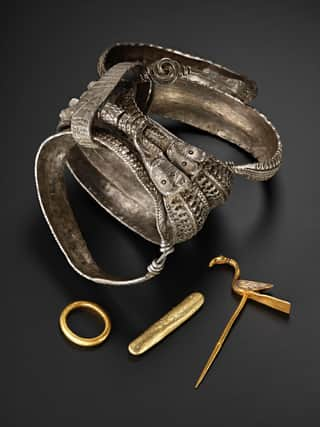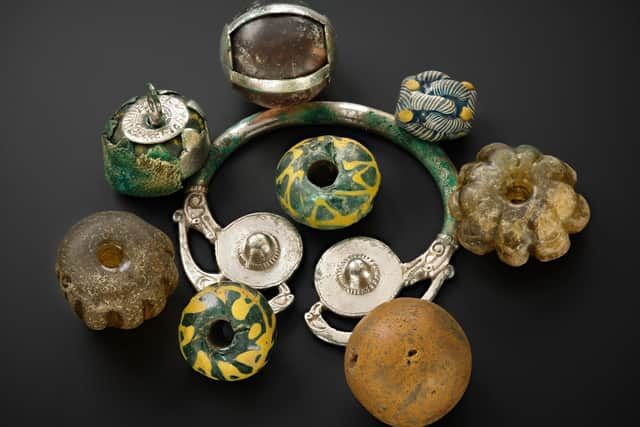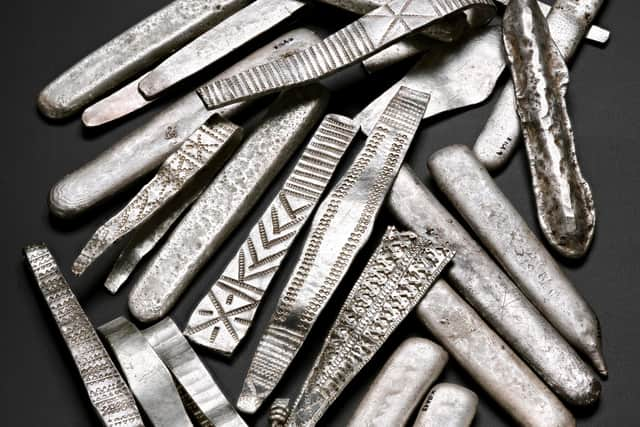Mystery of the four people who buried the spectacular Galloway Hoard of Viking treasures


Fascinating new details about the collection of gold, silver, jewellery, curios and cloths buried in south west Scotland more than 1,000 years ago have been shared ahead of the highly-anticipated opening of Galloway Hoard – Viking-age Treasure at National Museum of Scotland on Saturday.
The hoard was buried in four layers with it now believed that four different people – or groups – may have been responsible for the elaborate deposit, which was made around 900AD.
Advertisement
Hide AdAdvertisement
Hide AdThe names Ed, Til and Ber, all thought to be Anglo-Saxon abbreviations, have been found engraved on silver arms rings with a fourth, longer Runic inscription yet to be translated.


Dr Martin Goldberg, principal curator of medieval archaeology at NMS, said : “We believe four owners buried the hoard. There are four separate groups of arm rings in the hoard but they are not equal in quality so we believe the four owners may not be equal in status.
"These inscriptions bring the people connected to the hoard to the fore. Quite often with people in the past, there is no face.
"We are trying to bring them back to life with the treasures, the objects, that they valued. The combination of these names will be intriguing for historians who will try to determine who these characters were and the connections between them.”


The hoard, which contains more than 100 items, was discovered in Dumfries and Galloway by metal detectorist Derek McLennan in 2014. It was acquired for the national collection for a price of £2m.
Dumfries and Galloway was part of the kingdom of Northumbria at the time it was buried.
Dr Goldberg said: “The classic stereotype of a hoard is that people are under threat and they don’t want to lose their wealth, so they bury it in the ground so they can come back and reclaim it. That is the standard explanation."
But Dr Goldberg said it was hoped to develop another, fuller story around the Galloway Hoard.
Advertisement
Hide AdAdvertisement
Hide AdAnalysis of a silver-gilt vessel that made up one of the layers, and was packed full of carefully wrapped objects, from beads to pendants and a rock crystal jar, resulted in a “mindblowing” discovery for the museum, Dr Goldberg said.
Only two other lidded vessels have been found in Viking hoards in Britain and Ireland, both which originated from the Continent. The Galloway Hoard vessel is now known to have come from Central Asia.
Wrapped in wool, it is too fragile to go on show with a 3D model allowing for its highly-decorated surface to be seen for the first time in 1,000 years.
Dr Goldberg said: "The decoration and design show leopards, tigers and Zoroastrian religious symbols, all of which suggest that it is a piece of Central Asian metalwork from halfway round the known world.”
The vessel dates to 680-780AD with it likely to have been moved along vast trade routes from Asia through Russia and into Europe. A three-year research programme into the hoard is now underway at Glasgow University.
The exhibition, supported by Baillie Gifford, is free but places must be booked on the NMS website in order to limit numbers due to the pandemic.
A message from the Editor:
Thank you for reading this article. We're more reliant on your support than ever as the shift in consumer habits brought about by Coronavirus impacts our advertisers.
If you haven't already, please consider supporting our trusted, fact-checked journalism by taking out a digital subscription.
Comments
Want to join the conversation? Please or to comment on this article.
